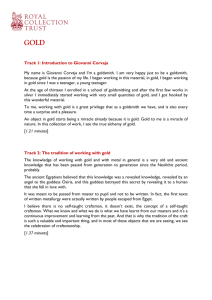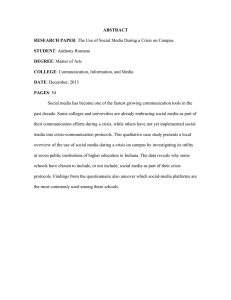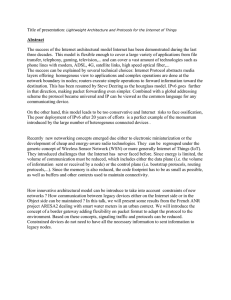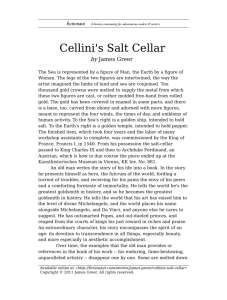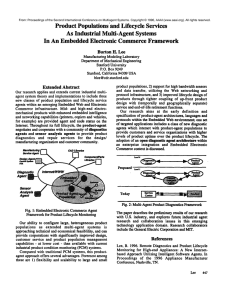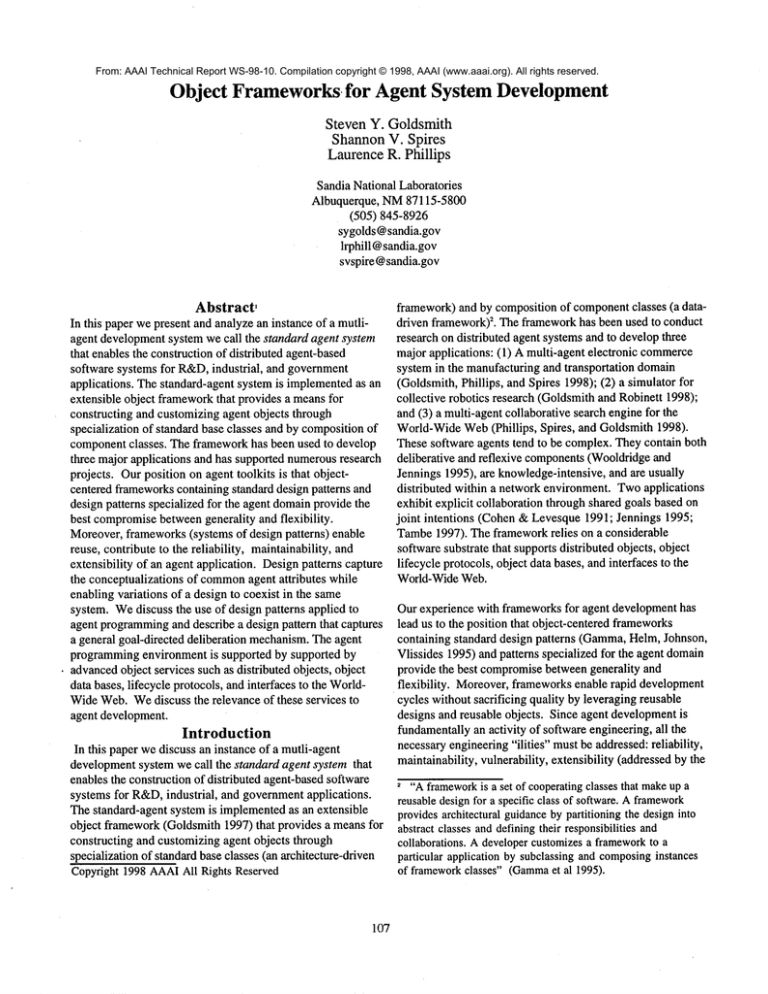
From: AAAI Technical Report WS-98-10. Compilation copyright © 1998, AAAI (www.aaai.org). All rights reserved.
Object Frameworks. for Agent System Development
Steven Y. Goldsmith
Shannon V. Spires
Laurence R. Phillips
Sandia National Laboratories
Albuquerque, NM87115-5800
(505) 845-8926
sygolds @sandia.gov
lrphill@ sandia.gov
svspire @sandia.gov
Abstract’
framework)and by composition of componentclasses (a data2. The frameworkhas been used to conduct
In this paper we present and analyze an instance of a mutlidriven framework)
research
on
distributed
agent systems and to develop three
agent developmentsystem we call the standard agent system
that enables the construction of distributed agent-based
major applications: (1) A multi-agent electronic commerce
software systems for R&D,industrial, and government
system in the manufacturing and transportation domain
applications. The standard-agent system is implementedas an (Goldsmith,Phillips, and Spires 1998); (2) a simulator
collective robotics research (Goldsmithand Robinett 1998);
extensible object frameworkthat provides a meansfor
and (3) a multi-agent collaborative search engine for the
constructing and customizing agent objects through
specialization of standard base classes and by compositionof World-WideWeb(Phillips, Spires, and Goldsmith 1998).
These software agents tend to be complex.They contain both
componentclasses¯ The frameworkhas been used to develop
three major applications and has supported numerousresearch deliberative and reflexive components(Wooldridgeand
Jennings 1995), are knowledge-intensive,and are usually
projects. Our position on agent toolkits is that objectdistributed within a networkenvironment. Twoapplications
centered frameworkscontaining standard design patterns and
exhibit explicit collaboration through shared goals based on
design patterns specialized for the agent domainprovide the
joint intentions (Cohen & Levesque1991; Jennings 1995;
best compromisebetweengenerality and flexibility.
Moreover,frameworks(systems of design patterns) enable
Tambe1997). The frameworkrelies on a considerable
software substrate that supports distributed objects, object
reuse, contribute to the reliability, maintainability, and
extensibility of an agent application. Designpatterns capture lifecycle protocols, object data bases, and interfaces to the
the conceptualizations of common
agent attributes while
World- Wide Web.
enabling variations of a design to coexist in the same
Our experience with frameworksfor agent developmenthas
system. Wediscuss the use of design patterns applied to
agent programming
and describe a design pattern that captures lead us to the position that object-centered frameworks
a general goal-directed deliberation mechanism.The agent
containing standard design patterns (Gamma,Helm, Johnson,
programmingenvironment is supported by supported by
Vlissides 1995) and patterns specialized for the agent domain
¯ advancedobject services such as distributed objects, object
provide the best compromisebetween generality and
data bases, lifecycle protocols, and interfaces to the Worldflexibility. Moreover,frameworksenable rapid development
cycles without sacrificing quality by leveraging reusable
WideWeb.Wediscuss the relevance of these services to
agent development.
designs and reusable objects. Since agent developmentis
fundamentallyan activity of software engineering, all the
Introduction
necessaryengineering"ilities" mustbe addressed:reliability,
In this paper we discuss an instance of a mutli-agent
maintainability,
vulnerability, extensibility (addressedby the
developmentsystem we call the standard agent system that
enables the construction of distributed agent-basedsoftware
2 "Aframework
is a set of cooperatingclasses that makeup a
systems for R&D,industrial, and governmentapplications.
reusabledesignfor a specific class of software¯A framework
The standard-agent system is implementedas an extensible
providesarchitectural guidanceby partitioning the design into
object framework(Goldsmith 1997) that provides a meansfor abstract classes and definingtheir responsibilities and
constructing and customizing agent objects through
collaborations¯ A developercustomizesa frameworkto a
specialization of standardbase classes (an architecture-driven
particular application by subclassing and composinginstances
Copyright 1998 AAAIAll Rights Reserved
of frameworkclasses" (Gamma
et al 1995)¯
107
frameworkapproach), safety, and others. Clearly an agent
toolkit must at least foster goodprogramming
practices and
encouragedesirable non-functionalengineering attributes in
addition to simplifying the functional developmentof the
agent application. Frameworkscontribute positively to most
of these attributes. Wesuggest that agent development
toolkits provide a collection of design patterns in the form of
a developmentframeworkfor agents that supports the
developmentof single agent and multi-agent systems:
(1) Standard Agency;(2) Standard Agent; and (3) Standard
Goal. Additional design patterns apply to component
subsystems of the Standard Agent pattern. The remainder of
this paper discusses the object developmentenvironment, the
standard agent framework,and summarizesthe relevance to
general issues in agent toolkits.
Supporting Software
The agents we refer to in this paper are complexobjects that
must be supported by an advanced object programming
environment. In our experience, agents system development
for both research projects and fielded applications requires a
sophisticated object programming
substrate that supports the
following services:
Distributed Objects - A distributed object systemthat
supports proxies, copies, replicants, remotemethod
invocation, global object identity, class coercion, and
object brokering. A networkagent uses distributed
object services to exchangemessageswith other agents,
to register itself in a foreign domain,and to provide
automaticcoercion of objects into proxies, replicants or
copies.
methodsto reason about incomplete information.
Agentscan use standard protocols to handle object
collections such as data base records, cases for case-based
reasoning, and images.
Object-HTMLA protocol for rapid development of
complexHTML
forms interfaces that includes a
compiler that renders an HTML
stream as a composite
object (tree) that can be searchedand modifiedby
agent. This service enables agents to conduct complex
elicitation sessions with users through a webbrowser.
Meta-ObjectProtocol - A protocol That enables
introspection and intercession on class and method
metaobjects. An agent can reason about classes and
methods, and can define new classes and methodsat
runtimeto alter its internal functions.
Not every agent application requires these advancedobject
services. However,manyfull-blooded agent applications
with somedegree of missioncriticality will require all of
them. Anagent toolkit can be evaluated along a support
services dimension by determining the degree to which its
underlying developmentenvironmentprovides these services.
Agent Design Patterns
Designpatterns are often partitioned into three kinds:
conceptual patterns, design patterns, and programming
patterns (Riehle and Zullighoven 1996). A conceptual pattern
is described by terms and concepts froma particular
application domain. A pattern describing the concept of joint
intentions is an exampleof a conceptual pattern in the agent
domain. A design pattern is described in terms of software
Object Data Base - Anobject oriented data base, fully
constructs, such as objects, classes, inheritance, and
integrated with the distributed object system, that
operators. It elaborates a conceptualpattern by specifying a
provides persistence, identity, storage of composites,
software implementation. An exampleof a design pattern for
large binary objects such as text and images, versioning, agent goals is given below. Programmingpatterns are
transactions, and meta-data storage. The object data base expressed in programminglanguage elements. Programming
gives an agent multiple independentpersistent object
patterns commita design pattern to a language-specific
stores that can contain specific ontologies and can record implementation. Macrosare typically used to implement
state informationfor fault recovery.
programmingpatterns. The example design pattern shown
belowdescribes a mechanism
for controlling the state of a
Object Lifecycle Protocol - A protocol for management user-specified goal. Thepattern provides a standard protocol
of the entire object lifecycle, fully integrated with the
that the developercan use to alter the state of a goal
distributed object service and the object data base service, according to a well-knownstate transition diagram. It
that includes an object factory, an object destruction
captures concepts that are common
in goal-directed reasoning,
or deliberative agents, in terms of classes, objects, and
protocol, examination and update protocols, object
collections and iterators, compositeobjects, and
operators. As such, it is language-independentand can be
protocols for handling unknownand incompletely
implementedin any object-oriented language. However,it
does assumethe existence of a meta-object function that
specified composites. Agentsuse the object lifecycle
protocol to create and destroy complexobjects (including changesthe class of an instance at runtime.
agents) while maintainingreferential integrity. Agents
can represent incompleteobjects and use standard
108
Goal
Intent
Separate meta-reasoning about the state of a goal from the implementationof the reasoning
mechanismused to satisfy the goal.
Motivation
The state of a goal can change over time. The deliberative mechanismcan reason about the state
of a goal independent of the specific reasoning mechanismused to attempt to achieve the goal. A
set of standard goal states is implementedto provide the programmerwith a meta-reasoning
protocol that alters the state of a goal according to user-specified conditions. Anachievable goal
is a goal that the agent believes can be satisfied and the agent will expendcomputational
resources to attempt its satisfaction. An achievedgoal is a goal that an agent believes it has
successfully satisfied. Adefective goal is an ill-formed goal that lacks critical state data or is
otherwise incoherent and cannot be achieved. A deferred goal is a goal that the agent believes
cannot currently be satisfied without external information or a changein the state of the
environment.External goals are goals that are copied for export to another agent or are goals
received from another agent. An internal goal is a private copy of a goal ownedby the agent.
Irrelevant goals are goals that no longer have motivational support. Unachievablegoals are
well-formedgoals that the agent believes cannot be satisfied.
Applicability
The Goal pattern is used to implementa general mechanismfor handling goals that provides
standard classes and semantics for goal states. The programmercan create application subclasses of
the goal class and specialize the achieve methodto implement a reasoning mechanismfor the
subclass. The state classes can also be subclassed to create a customstate-handling mechanism.
Structure
I
Achievable-Goal
I
I] Achieved-Goal
Defective-Goal
reason-for-defective
Deferred-Goal
reason-for-deferral
I
External-Goal
Goal
achieve 0
achieved()
achievable
0
defective 0
deferred 0
external 0
internal 0
irrelevant
0
unachievable
0
identifier
state-variables
[
Internal-Goal
I
Irrelevant-Goal
Unachievable-Goal
reason-for-default
2
Application-Goal
109
Participants
The state operators alter the class of the user goal to reflect the current state of the goal. Each
operator pushes its respective state class on the precedence list of the user goal and changes the
class of the goal to the state class. Side effects such as removing the goal from an agenda
(irrelevant-goal,
unachievable-goal, defective-goal) or placing the goal on an agenda
(achievable-goal,
deferred-goal) can be implemented in the state operator methods. A goal
object can be destroyed (changed to the class olp::unknown) by the kill operation imported from the
Object Lifecycle Protocol package. The state evolution of a goal is illustrated in the figure below.
The state operator methods are used by the programmer to assert the state of the goal. Overloaded
state operators enforce the admissible state transitions by performing a NOP. For example, the
achieved operator is defined on the class goal to implement a NOP, and asserts the achieved state
only on goals of class achievable.
achieved
)::kill
~ unkn°wn )
achieved
deferred
deferred
achievable
achievable
irrelevant
external
internal
irrelevant
internal
anachievable
olp::kill
ol
unknown
defective
defective
olp::kill
Collaborations
The client invokes a state operator from a method specialized to handle the application goal.
The defective, achieved, unachievable, irrelevant,
and deferred methods are typically invoked
in a specialized achieve method. The internal operator is typically invoked by the agent’s
communications interface or by the make-goal method.
Consequences
The goal pattern gives the programmer the freedom to choose the state variables and the reasoning
mechanism used to achieve an application goal while providing a standard mechanism for
handling the state of the goal.
110
Standard
Agent Framework
The standard agent framework(SAF) is an exampleof
extensible object frameworkthat supports numerousstandard
and customdesign patterns. The SAFprovides a meansfor
constructing and customizing multiagent systems through
specialization of standardbase classes (architecture-driven
framework)and by composition of componentclasses (datadriven framework). The standard agent frameworkcomprises
two associated abstract classes: agent and agency.3 An
agencyidentifies an independentlocus of processes,
activities, and knowledgetypically associated with an
company,organization, department, site, household,
machine,or someother natural partitioning of the
application domain. The underlying assumptionis that the
application is naturally modeledas a group of interacting
agencies. The agencyprovides a containing context for a
collection of agents. The activities of the agencyare
conductedby its constituent agents. Agents inhabit an agency
for the express purpose of providing services , including
intra-agency communications,that maintain the functioning
of the agencyand lead to satisfaction of the ultimate
objectives of the agency. An agent performs domain-specific
tasks on behalf of humanactors and other agents. The class
agent can be subclasses and the methodsthat implement
primitive agent behaviors can be specialized to achieve agent
speciation. Agentspecies are differentiated at an intrinsic
level in terms of their normativegoals and behaviors, largely
determined by composition through instantiation with
behavioral components.Different species of agents will vary
along one or moredimensionsthat are captured in the object
protocols that implementthe particular design decision.
Standardized agent systems are implementedby the
specialization and instantiation of four concrete classes: (1)
Standard Agency;(2) Standard Agent; (3) HumanActor;
(4) Resources. The class Standard Agencyis an elaboration
of the agencyconcept that includes humanactivities within
the agencyand devices for data-oriented activities such as
storage and communications.An instance of Standard
Agencyis a persistent, identity-bearing compositeobject that
contains collections of the componentclasses Standard
Agent, HumanActor, and Resources. A standard agency
object inherits collection behavior from the collection mixin
class, and uses the standardcollection iterator pattern
(Gammaet al 1995) to provide an enumeration methodfor its
components.The protocols for the Standard Agencyclass are
primarily introspective methodsthat return component
instances to enable an overviewof agency status for debug
and display purposes. The state of the agencyobject evolves
3 "Anabstract class is a designfor a single object. A framework
is the designof a set of objects that collaborateto carry out a set
of responsibilities. Thus, frameworks
are larger scale designs
than abstract classes." (Johnsonand Russo1991).
111
in time as humanactors, agents, and resources are addedand
deleted. The agencyobject provides only a containing context
for its components,but conformsto the Abstract Factory
design pattern (Gamma
et al 1995) that implements
complexconstruction protocol for agencies.
The class Standard Agent implementsinstances of agents that
havespecific attributes: autonomy,social ability, reflexivity,
and pro-activeness. Aninstance of Standard Agentis a
composite object containing collections of component
objects that define its structure and behavior. The primary
Standard Agentprotocols are an interface mechanismthat
enables interaction with other agents and humanactors, a
reflexive action mechanismfor rapidly respondingto event
objects in its environment,and a generic inference
mechanismfor achieving explicit goals. The interaction and
inference protocols can be specialized with methodsthat
violate the standard design pattern and implementother agent
architectures and mechanisms.Agents are self-contained
threads of executionthat execute both periodically and
through immediate scheduling. The concrete componentclass
Standard Goal implements a general achievement goal. An
agent’s agendacontains descendants of Standard Goal that
define the agent’s motivations. Standard Goal mayalso be
subclasses and its protocols specialized to implement
modular knowledgeto achieve well-knownclasses of goals.
Mixingoal behaviors are possible that define reusable
canonical goal behaviors useful in manyapplications. For
example, conducting an interactive session with a human
informant has manycommon
aspects to it that are
independent of the domain or subject. These common
aspects are captured in the mixin elicitation-goal that
abstracts awayfrom the subject goal design things like user
timeout handling, stream and i/o management,and humanagent synchronization. A specialized concrete subclass of
standard goal implementsa Joint Persistent Goal (JPG)
the design pattern supporting collaboration through joint
intentions. Thenjoint intentions pattern supports extensions
for team formation (Tambe1997) as well.
Human
actors are objects in the agent domainthat represent
people interacting with agents through an interface device. A
person logs into the agencytemporarily for a worksession
through an interface device. Humanactor objects are
temporaryobjects that contain an interface address, an
interface object that captures the display, data entry and
control functions currently available to the person, and a
persistent person object that holds personal data, passwords,
email address, and an account object that provides access to
past and current workspaces. A workspaceobject contains
objects created and stored by the person during worksessions.
Agents and humanactors have access to resources such as
databases, fax machines,telephones, email handlers, signal
processors, controllers, and other useful services. Resource
objects provide concurrencycontrol and access protocols for
agencyresources. Subclasses of the resource class implement
objects representing data bases, fax machines,printers, email
ports, EDIports and other commonplace
legacy devices in
the agencyenvironment.Interfaces to these devices are
abstracted in numerousstandard design patterns.
specifications for the pattern and enables fair comparisonof
toolkits.
The Standard Agent Frameworksupports distributed agent
systems through the distributed objects layer. Agency
objects maybe distributed in a networkenvironmentto create
a collaborative enterprise structure of interconnectedagencies.
Agencyobjects are represented The fundamentalactivity
conductedamongdistributed agencies is the trading of domain
objects through proxy agents that represent one agency
within the agent collection of another agency. Theseproxy
objects delegate all messages(except for a local request for
identifying information about the represented agency) to the
actual agent residing in the agency. Public proxies are
registered in an agency network phonebookwith a well-know
address. To find other agencies, an agent issues one or more
queries to the phonebookand is returned the proxy objects
matchingthe query. The agent proxies interned within an
agency form a persistent network of agencies. Such networks
are called durable proxy networks. Agentscan also directly
intern proxies to other agents to form private networksof
collaborating agents.
Gamma,E.,Helm, R., Johnson,R., Vlissides,J.,. Design
Patterns: Elements of Reusable Object-Oriented Software.
Addison-Wesley1995. ISBN0-201-63361-2.
Agents can communicatevia variety of communications
standards. A subclass of Standard Goal called KQML-Goal
implements sensing, receiving, and interpreting KQML
messages amongagents. The JPG goal makes use of
KQML-Goal
as a subgoal to implement cooperation via
shared goals. Agents can also communicatedirectly with
WWW
servers via a standard object representation of HTML
pages and a protocol that provides a stream abstraction for the
server in the agent environmentas a resource object.
Discussion
Wehave exhibited an exampleof an agent design pattern and
discussed an exampleof an agent developmentframework.
Wesuggest that agent toolkits can be evaluated according to
the support services they provide. Designpatterns, organized
into a developmentframework, provide a meansto evaluate
agent development toolkits. Agent development systems can
be evaluated against a collection of standard design patterns,
developed by the community,that describe common
architectures such as Belief-Desire-Intention (Georgeff &Rao
1995). Design patterns capture agent componentsin standard
object notation that can be implementedin a variety of
languages. The pattern description format accepted in the
design pattern research enables clear communication
of the
112
Acknowledgements
Sandia is a multiprogramlaboratory operated by Sandia
Corporation, a LockheedMartin Company,for the United
States Department of Energy under Contract DE-AC0494AL85000.
References
Cohen, P., and Levesque, H. 1991. Teamwork.Nous, 25.
Georgeff, M. and Rao, A. 1995. BDIagents: from theory to
practice. In Proceedingsof the First International Conference
on Multi-Agent Systems (ICMAS-95).
Goldsmith, S. Y. 1997. The Standard Agent Framework.
AdvancedInformation Systems Laboratory Report, Sandia
National Laboratories, Albuquerque, NM.
Goldsmith, S. Y., Phillips, L. R., Spires, S. V. 1998. A
Collaborative Multiagent Systemfor International Shipping.
Accepted for the Workshopon Agent-MediatedTrading,
Agents ’98 Conference, Minneapolis MN.
Goldsmith, S., Robinett, R. 1998. Collective Search by
Mobile Robots using Alpha-Beta Coordination. Acceptedfor
the Workshopon Collective Robotics (CRW98),Agent
World98, Paris, France.
Phillips, L. R., Spires, S. V., Goldsmith,S. Y. 1998.
Distributed Search by an AgentCollective. Submittedto the
Workshopon Learning for Text Categorization, AAAI-98,
Madison WI.
Jennings, N. 1995. Controlling cooperative problem solving
in industrial multi-agent systems using joint intentions.
Artificial Intelligence, 75.
Johnson, R., Russo, V. 1991. In Reusing Object-Oriented
Designs.
Riehle D., Ziillighoven H. 1996. Understandingand using
patterns in software development.In Theory and Practice of
Object Systems 2, 1.
Tambe, M. 1997. Towards Flexible Teamwork.Journal of
Artificial Intelligence Research7, 83-124.
Woolridge, M. and Jennings, N. 1995. Intelligent Agents:
Theory and Practice. In KnowledgeEngineering Review.

